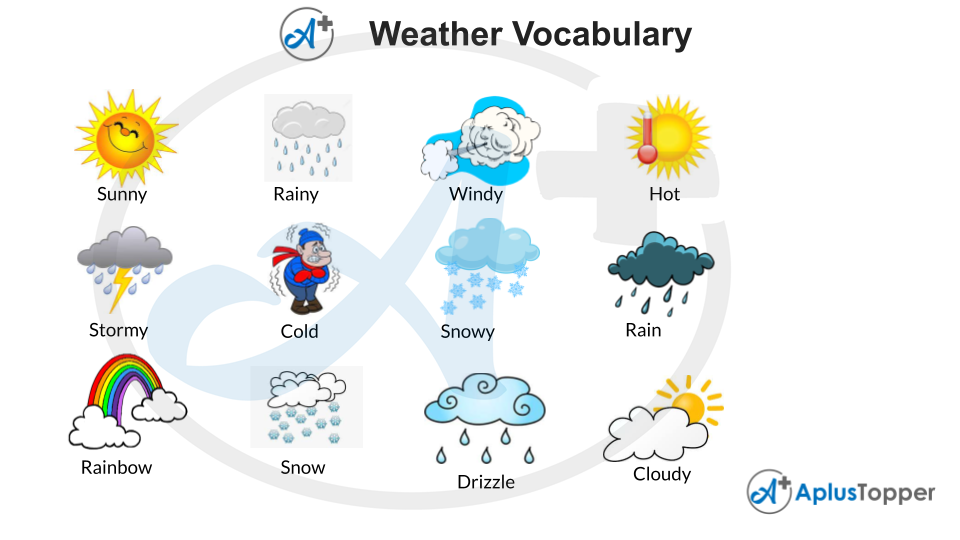Weather Vocabulary: There are a lot of weather words in English. It is difficult for someone to remember them all at a go. Nonetheless, you come across words related to weather during a conversation, or while watching a TV show, or while going through books or study materials. You must know the meaning of the words to have proper communication. So here is a list of weather vocabulary that will help you increase your knowledge and add a few words to your everyday use.
Study the most important English Vocabulary Words identified by our experts and learn the right vocabulary to use in your day to day conversations.
List of Weather Vocabulary words in English
Name of Weather Vocabulary words
Weather describes the state of the atmosphere, such as how hot or cold it is, how wet or dry it is, and how clear or foggy it is. This list consists of weather-related words and definitions of the same so that you can understand them well. These words related to sky and weather will help you with an effective way to communicate or understand things better.
List of Weather Vocabulary
- Balmy
- Blustery
- Breeze
- Cloudy
- Cold
- Cold Front
- Dew
- Downpour
- Drizzle
- Easterlies
- Fog
- Frost
- Gale
- Gust
- Icicle
- Lightning
- Mist
- Muggy
- Overcast
- Permafrost
- Rain
- Rainbow
- Sleet
- Smog
- Snow
- Snowfall
- Tropical
- Warm
- Westerlies
- Whirlwind
- Wind
- Wind Chill

Description of the Weather Vocabulary words.
Balmy
Balmy weather is mild and pleasant and is characterized by warm weather.
Blustery
Blustery is the weather that is characterized by strong winds.
Breeze
It is a light, pleasant wind that can either be warm or cold.
Cloudy
Cloudy weather occurs when the sky is obscured by clouds.
Cold
We call it cold weather
when the weather is at a relatively lower temperature than our human body.
Cold Front
A cold front is the extreme end of a cooler air mass at ground level that replaces a warmer mass of air and is located within a deep surface low pressure trough.
Dew
Dew is droplets of water that form on thin, exposed objects in the morning or evening owing to condensation. As the exposed surface cools by radiating heat, air moisture condenses faster than it can evaporate, resulting in water droplets.
Downpour
A downpour is characterized by heavy rainfall.
Drizzle
Drizzle is a type of light liquid precipitation consisting of liquid water drops smaller than raindrops – typically less than 0.5 mm in diameter. Stratocumulus clouds and low stratiform clouds typically create drizzle.
Easterlies
The trade winds, also known as easterlies, are the persistent east-to-west winds that blow in the Earth’s equatorial region.
Fog
Fog is a visible aerosol made up of microscopic water droplets or ice crystals floating in the air near or on the Earth’s surface. Fog is a low-lying cloud that resembles stratus and is significantly impacted by neighboring bodies of water, geography, and wind conditions. Fog, in turn, has an impact on many human activities, including shipping, travel, and warfare.
Frost
Frost is the thin layer of ice formed on a solid surface when water vapor in an above-freezing atmosphere comes into contact with a solid surface below freezing, resulting in a phase shift from water vapor to ice as the water vapor approaches the freezing point. It most typically appears on surfaces near the ground as delicate white crystals in temperate regions; in frigid climates, it appears in a broader range of forms.
Gale
A gale is a violent wind that is commonly used in nautical contexts as a descriptive. When winds of 34–47 knots are forecasted, forecasters often issue gale warnings.
Gust
A gust, also known as a wind gust, is a transient increase in wind speed that lasts less than 20 seconds. It is more fleeting than a storm, which lasts minutes and is followed by a lull or a wind slowing. Winds are generally least gusty over big bodies of water and most gusty over rocky terrain and near tall buildings.
Icicle
An icicle is a spike of ice generated when waterfalls from a frozen object.
Lightning
Lightning is a naturally occurring electrostatic discharge in which two electrically charged regions, either in the atmosphere or on the ground, temporarily equalize, resulting in the sudden release of up to one gigatonne of energy. This discharge can produce a wide range of electromagnetic radiation, from heat generated by the rapid flow of electrons to dazzling bursts of visible light in the form of black-body radiation.
Mist
Mist is a natural occurrence generated by microscopic droplets of water floating in the air. It is a physical example of dispersion. It is most typically observed where warm, moist air meets quick cooling, as in exhaled air in the cold or splashing water into a hot sauna stove.
Muggy
Muggy refers to a combination of humidity and heat that causes you to sweat and feel uncomfortable, making you desire air conditioning.
Overcast
Overcast, often known as overcast weather, is a meteorological situation in which clouds obscure at least 95 percent of the sky. On the other hand, the overall cloud cover cannot be attributed to obscuring phenomena near the surface, such as fog.
Permafrost
Permafrost is defined as ground that has consistently remained below 0 °C (32 °F) for two or more years and can be found on land or under the sea. Permafrost does not have to be the ground’s first layer. It can range in depth from one inch to several miles beneath the Earth’s surface.
Rain
Rain is liquid water in droplets condensate from air-water vapor and becomes heavy enough to fall due to gravity. Rain is an integral part of the water cycle since it is responsible for depositing the majority of the fresh water on Earth.
Rainbow
A rainbow is a meteorological phenomenon created by the reflection, refraction, and dispersion of light in water droplets collide, causing a spectrum of light to appear in the sky. It resembles a multicolored circular arc. Sunlight-induced rainbows always appear in the part of the sky directly opposite the Sun.
Sleet
Sleet is a different type of precipitation than snow, hail, and freezing rain. It is formed when a temperature inversion causes snow to melt and then refreeze in particular weather circumstances.
Smog
Smog is an air pollution named from the combination of smoke and fog in the air. Classic smog is formed by a mixture of smoke and Sulphur dioxide caused by significant amounts of coal burning in a region.
Snow
Snow is composed of individual ice crystals that form while hanging in the atmosphere (typically within clouds) and then fall to the ground, where they undergo additional modifications. Throughout its life cycle, it is made up of frozen crystalline water.
Snowfall
Snowfall is what we term a snowfall, namely the amount of snow that falls in a single storm or over a specific period.
Tropical
A tropical climate is found in the tropics. It has a humid environment with typical temperatures exceeding 18°C (64.4 °F) throughout the year. Rainfall occurs throughout the year in some tropical places, mainly in the afternoon. Others, for example, have a rainy season and a dry season as a result of the monsoon.
Warm
Warm weather is characterized by a moderate degree of heat when the weather is moderately hot.
Westerlies
The westerlies, also known as anti-trades or prevailing westerlies, are prevailing winds that blow from the west to the east in the middle latitudes between 30 and 60 degrees latitude. They form in high-pressure regions in the horse latitudes, move towards the poles, and drive extratropical cyclones in this general direction.
Whirlwind
A whirlwind is a weather phenomenon that occurs when a vortex of wind emerges due to instabilities and turbulence caused by heating and flow gradients. Whirlwinds can occur at any time of year and in any location on the planet.
Wind
Wind can be defined as the natural movement of air or other gases on the surface of a planet. Wind occurs on various scales, from thunderstorm flows lasting tens of minutes to local breezes formed by heating land surfaces and lasting a few hours to global winds caused by differences in solar energy absorption between Earth’s temperate zones.
Wind Chill
The wind chill is a word that meteorologists use during the colder months of the year. Forecasters may also refer to this as the “feels-like” temperature because the wind chill is essentially how cold it feels on your skin when the wind is factored in.
